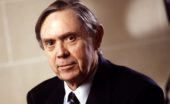Johannah Bernstein post: "eternally proud of my father’s extraordinary aeronautical engineering. legacy. here is a photo of the Canadair Water…
James E. (Jim) McInerney R.I.P.
Written by Diana Thebaud Nicholson // June 5, 2015 // Absent Friends // 2 Comments
Photo: Retired Air Force Maj. Gen. James E. McInerney Jr., left, who received the Air Force Cross as a combat pilot in the Vietnam War, with Maj. Fred Shannon, right. (USAF )
James E. McInerney Jr., major general who received the Air Force Cross, dies at 84
Washington Post, November 2, 2014
By Bart Barnes
James E. McInerney Jr., a retired Air Force major general who was a combat pilot during the Vietnam War and who received the Air Force Cross for taking out enemy defensive weaponry in a 1967 raid on a strategic bridge near Hanoi, died Oct. 14 at a hospital in Washington. He was 84.
The cause was cardiopulmonary arrest, said his son, Jake McInerney.
Gen. McInerney was one of five airmen to receive the Air Force Cross — that service’s highest decoration for valor after the Medal of Honor — in the Aug. 11, 1967, attack on a bridge formerly called the Paul Doumer Bridge, which was a vital supply and troop conduit for enemy forces.
According to Airman magazine, an official publication of the Air Force, there had not been so many high combat decorations awarded for a single mission since a 1943 raid on the Ploesti oil fields of Romania during World War II.
In an eight-day period in May 1967, then-Lt. Col. McInerney also received three Silver Star commendations for air combat. He was commander of the so-called “Wild Weasel” air squadron whose purpose was to damage or destroy antiaircraft weaponry and surface-to-air missile launching sites. He was cited for his tactical use of evasive air tactics to elude enemy missiles.
As a “Wild Weasel” pilot, his job included serving as “bait,” or as a decoy, to help other airmen find enemy positions. This stratagem enabled the Wild Weasel aircraft to damage or destroy enemy defenses and to divert attention away from other U.S. forces. On 101 combat flights in Vietnam, Gen. McInerney never lost an airplane from his squadron.
He was “the greatest combat leader I have ever witnessed,” retired Air Force Gen. Joseph W. Ralston, a former vice chairman of the Joint Chiefs of Staff and Supreme Allied Commander for NATO, said in an interview.
James Eugene McInerney Jr. was born Aug. 3, 1930, in Springfield, Mass. His father was a career Army officer stationed at the Springfield Armory. He grew up at military bases across the country, including Washington. He graduated from the U.S. Military Academy at West Point, N.Y., in 1952, one of four McInerney brothers to do so.
In college, he was captain of the West Point boxing team and was Eastern intercollegiate light heavyweight boxing champion in 1951 and 1952. He had a chance to try out for the U.S. Olympic boxing team in 1952, according to news accounts, but he passed it up to attend flight training school.
Among Gen. McInerney’s early Air Force assignments was Korea, where as a junior pilot he shot down a Russian MiG-15 aircraft in 1955. The truce ending the Korean War had been in effect since 1953, but relations were tense, and there were periodic flare-ups between the two sides.
Flying escort with a reconnaissance aircraft, Gen. McInerney shot down one of three Chinese-piloted MiG-15s, which took “hostile and aggressive” action against the reconnaissance plane, said his brother, retired Air Force Lt. Gen. Tom McInerney.
Gen. James McInerney received a master’s degree in aeronautical engineering from Princeton University in the early 1960s and master’s degree in public administration from George Washington University a decade later. He served in England and Germany before going to Southeast Asia in 1967.
He had only recently arrived at his base in Thailand when his commanding officer relayed some bad news: His brother Richard, a captain in an Army special forces unit, had been killed in ground combat in Vietnam.
Although he was never brought down by enemy fire, Gen. McInerney was forced to eject from his plane over the jungle in Laos when returning from a night mission over Vietnam. His parachute got stuck in a tree, where he remained hanging throughout the night. The next day, he was rescued by a helicopter.
After Vietnam, Gen. McInerney served at the National War College and the Pentagon and in Turkey and Germany. He retired from the Air Force in 1980 as deputy chief of staff for programs and analysis.
He settled in Annandale, Va., and worked as a legislative specialist with the McDonnell Douglas aircraft corporation and later became a vice president of the National Defense Industrial Association.
For his work as a fundraiser for the American Air Museum in England, he was designated a commander of the British Empire. He was also a former president of the British American Business Association.
No matter where he was in the world, his son said, Gen. McInerney made it a point to attend a Roman Catholic mass at 7 o’clock every morning.
His wife of 38 years, Mary Catherine Hill McInerney, died in 2011.
Survivors include two children, Anne McInerney of Chevy Chase, Md., and Jake McInerney of Alexandria, Va.; a brother, retired Air Force Lt. Gen. Tom McInerney of Washington; and a sister, Patricia Whitaker of Sanibel, Fla.
In addition to his Air Force Cross and Silver Stars, Gen. McInerney also received seven Distinguished Flying Crosses. He was formally recognized by the Air Force Association as a “Living Legend.”
See also: In Memorium – MG James E. McInerney, Jr. USAF Retired
Born in Springfield, Massachusetts, on August 3, 1930, where his parents Captain James E McInerney and Rose Adikes McInerney were stationed at Springfield Armory, he was oldest of five children. A true leader, he spent his entire life in service in the Army, Air Force and defense industrial base.
Jim entered West Point in July 1948 after a stint with the 82nd Airborne Division, which was still manned with many WW II combat veterans who endowed Jim with a fierce combat spirit that he kept throughout his lifetime.
At West Point he was the Captain of the Army Boxing Team and the Eastern Intercollegiate Light Heavyweight Boxing Champion in 1951 and 1952.
He was very proud of the Class of ’52 and always kept in close touch with classmates. At graduation, Jim had to choose between trying out for the 1952 Olympic Boxing Team or going to Flight School to become a Fighter Pilot.
After his first assignment at Niagara Falls flying F-86s, he was posted to Korea. Jim shot down the last enemy MIG-15, piloted by a Chinese Communist, on May 10th 1955, as air combat continued well after the Korean Armistice was signed. This combat action brought international acclaim.
He is survived by his daughter Anne, son-in-law Earl Comstock, granddaughter Clare Comstock; son Jake and his girlfriend Debbie Seymour; sister Patsy Whitaker and brother-in-law Hubert; brother Tom (USMA ’59) and sister-in-law Mona; plus numerous cousins, nieces and nephews.
He will be buried at the West Point Cemetery, joining his wife Mary Catherine, Mother and Father (USMA ‘23), and brothers John (USMA ‘59) and Dick (USMA ‘60).




2 Comments on "James E. (Jim) McInerney R.I.P."
James E. McInerney Jr. (Princeton Graduate School – aeronautical engineer ’60)
I just read in this week’s Princeton Alumni Weekly that Jimmy died Oct 14th of cardiopulmonary arrest. So sad but he was 84. The obit notes he is survived by a brother and a sister. I know one of his brothers was also an AF General and I met him on several of my official visits to Germany at EUCOM. David
The Thayer Hotel Room dedication Program
THE MCINERNEY FAMILY, USMA 1923-1960
http://www.thethayerhotel.com/Accommodations/Room-Dedication-Program/M-P/McInerney